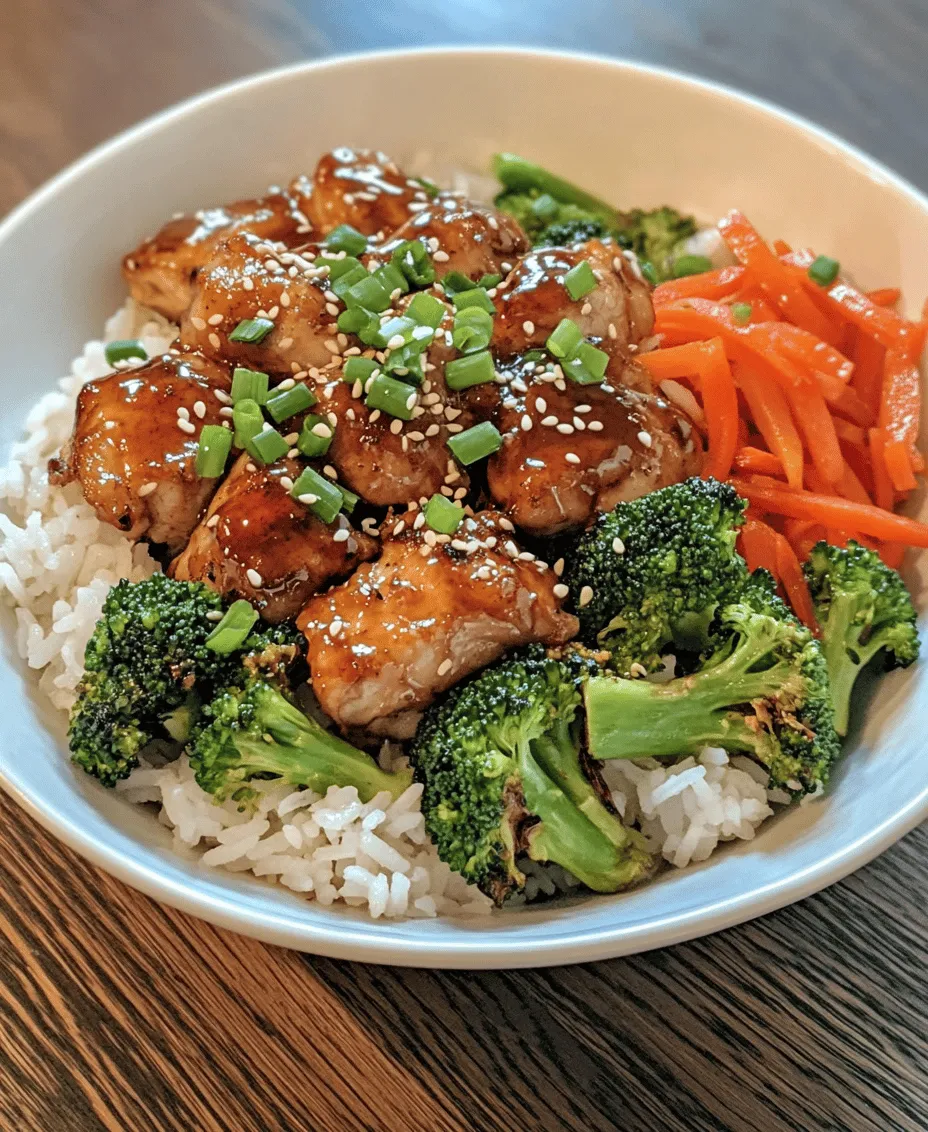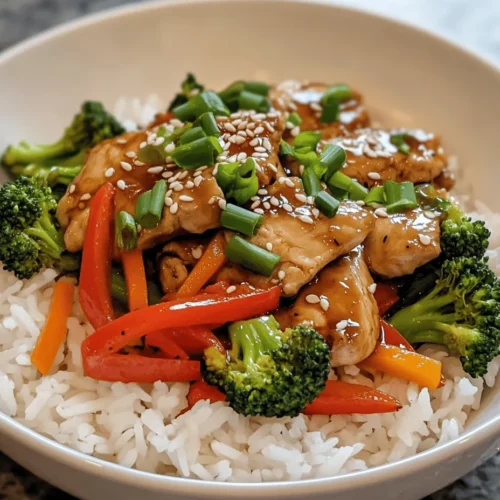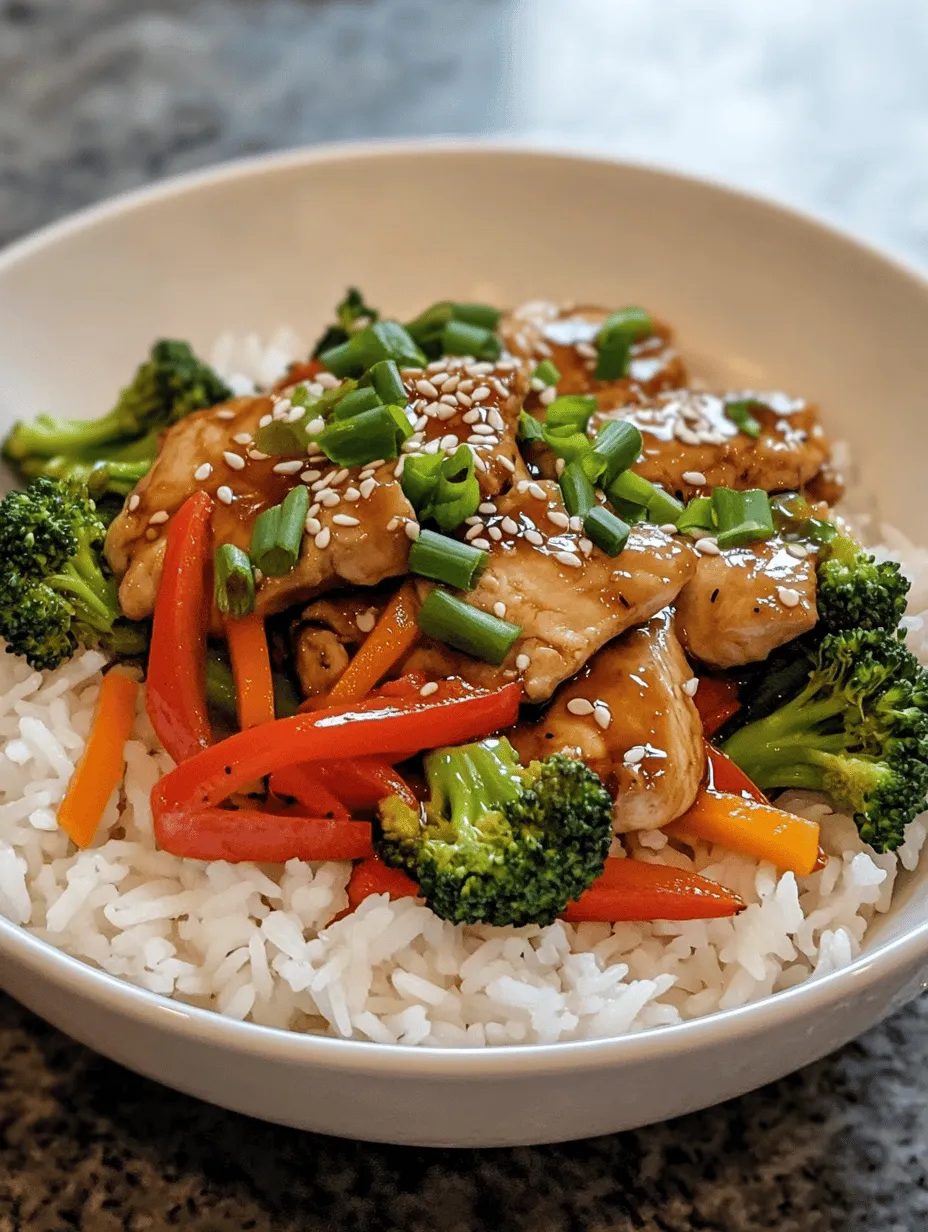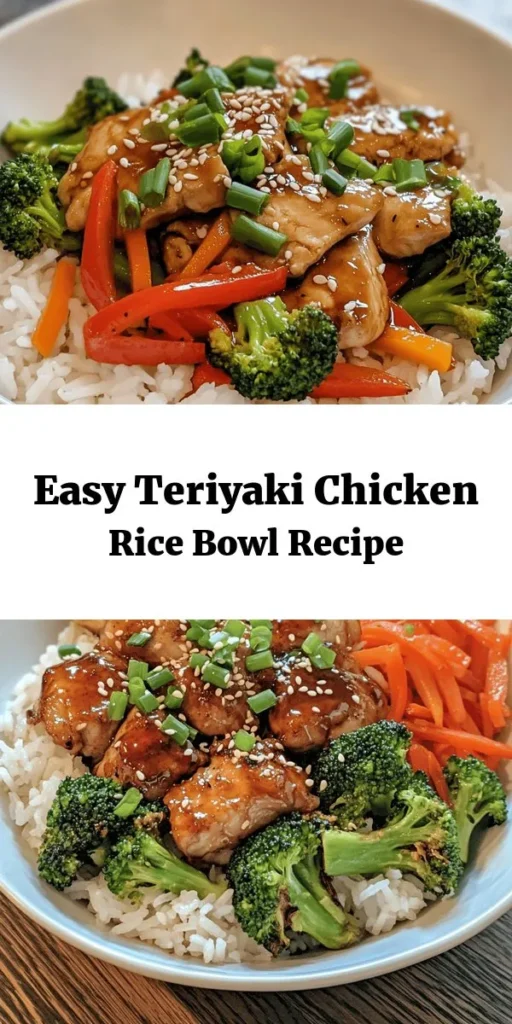Introduction
The Teriyaki Chicken Rice Bowl is a delightful fusion of flavors that brings the essence of Japanese cuisine right to your dinner table. This dish perfectly balances tender marinated chicken, vibrant vegetables, and fluffy jasmine rice, creating a wholesome and satisfying meal. It’s a dish that appeals to both the eyes and the palate, making it a perfect choice for family dinners or entertaining guests. The subtle sweetness of the teriyaki sauce combined with the savory notes of grilled chicken and the freshness of vegetables creates a symphony of flavors that is hard to resist.
In this article, we will explore every aspect of this recipe, from its intriguing origins to step-by-step instructions, ensuring that you can replicate this dish with ease and confidence. Whether you are a seasoned cook or a kitchen novice, you’ll find that preparing a Teriyaki Chicken Rice Bowl is not only simple but also incredibly rewarding.
Understanding Teriyaki: A Brief History
To truly appreciate the Teriyaki Chicken Rice Bowl, it’s essential to understand the roots of its star ingredient: teriyaki sauce. The term “teriyaki” comes from the Japanese words “teri,” meaning glaze, and “yaki,” which means to grill or broil. This cooking technique dates back to the Edo period (1603-1868) in Japan, where it was used to prepare various types of fish and meats.
Originally, teriyaki sauce was a simple blend of soy sauce, sake, mirin (a type of sweet rice wine), and sugar, used to marinate and glaze grilled foods. This method not only enhanced the flavor but also helped to preserve the meat. Over the years, teriyaki has evolved, incorporating various ingredients and flavors influenced by global culinary trends.
The cultural significance of teriyaki in Japanese cuisine is profound. It represents a fusion of flavor, technique, and tradition, embodying the Japanese philosophy of balancing taste and presentation. As Japanese cuisine gained popularity worldwide, teriyaki made its mark far beyond Japan. Today, you can find teriyaki chicken on menus from fast-food joints to upscale restaurants, each adding its unique twist to this classic dish.
Ingredient Spotlight: Key Components of Teriyaki Chicken Rice Bowl
The beauty of the Teriyaki Chicken Rice Bowl lies not only in its preparation but also in its ingredients. Each component plays a crucial role in delivering the dish’s signature taste and texture.
Chicken Thighs: The Preferred Cut
When it comes to the meat for this dish, chicken thighs are often preferred over other cuts. The reason is simple: chicken thighs are inherently more flavorful and juicier than chicken breasts. Their higher fat content ensures that they remain tender even when cooked at high temperatures, making them ideal for grilling or sautéing. The marination process allows the thighs to absorb the teriyaki sauce deeply, resulting in a rich and satisfying flavor.
Jasmine Rice: The Perfect Base
Jasmine rice serves as the perfect base for our Teriyaki Chicken Rice Bowl. This long-grain rice variety is known for its delicate floral aroma and slightly sticky texture, which helps to hold the flavors of the dish together. When cooked correctly, jasmine rice provides a soft and fluffy backdrop that complements the savory chicken and vibrant vegetables.
Broccoli, Bell Pepper, and Carrot: Enhancing Flavor and Nutrition
To round out the dish, a medley of colorful vegetables is essential. Broccoli, bell pepper, and carrots not only add visual appeal but also enhance the nutritional profile of the meal. Broccoli provides a satisfying crunch and is packed with vitamins C and K. Bell peppers contribute a sweet and slightly tangy flavor, while carrots add a subtle earthiness and a pop of color. Together, these vegetables create a beautiful contrast in both taste and texture, elevating the overall dish.
The Teriyaki Sauce: A Symphony of Flavors
No Teriyaki Chicken Rice Bowl would be complete without its namesake sauce. The teriyaki sauce is a harmonious blend of sweet and salty flavors, typically made from soy sauce, sake, mirin, and sugar. The balance of these ingredients gives the sauce its unique profile, enhancing the chicken’s natural flavors while adding depth to the dish.
For those who prefer a homemade touch, crafting your teriyaki sauce is simple and allows you to customize the sweetness or saltiness to your liking. The homemade version typically achieves a fresher taste than store-bought alternatives, ensuring your dish is as flavorful as possible.
Preparation Steps: A Detailed Walkthrough
Now that we have a solid understanding of the ingredients that make up the Teriyaki Chicken Rice Bowl, let’s dive into the preparation steps. Following these detailed instructions will ensure that your dish turns out perfectly every time.
Marinating the Chicken for Maximum Flavor
The first step in preparing your Teriyaki Chicken Rice Bowl is marinating the chicken thighs. This process allows the flavors of the teriyaki sauce to penetrate the meat, resulting in a more flavorful dish. Here’s how to do it:
1. Prepare the Marinade: In a bowl, combine soy sauce, mirin, sake, and a bit of sugar. You can also add minced garlic and grated ginger for an extra punch of flavor.
2. Marinate the Chicken: Place the chicken thighs in a resealable plastic bag or a shallow dish and pour the marinade over them. Ensure that all pieces are well-coated. Seal the bag or cover the dish and refrigerate for at least 30 minutes, although marinating for a few hours or overnight will yield even better results.
3. Remove Excess Marinade: Before cooking, remove the chicken from the marinade and let it rest for a few minutes. This step is crucial to get a good sear while cooking.
The Importance of Rinsing Jasmine Rice
While your chicken is marinating, it’s time to prepare the jasmine rice. Rinsing the rice is a critical step that many home cooks overlook, but it makes a significant difference in the final texture. Here’s what to do:
1. Measure the Rice: Determine how much jasmine rice you will need. A standard serving is about 1/2 cup of uncooked rice per person.
2. Rinse: Place the rice in a fine-mesh strainer and rinse it under cold running water. Gently rub the grains with your fingers to remove excess starch. Rinsing helps to produce a fluffier rice, preventing it from becoming gummy during cooking.
3. Drain: Allow the rice to drain thoroughly before cooking.
Cooking the Rice to Perfection: Techniques and Tips
Cooking jasmine rice is straightforward, but it requires attention to detail to achieve the ideal texture. Follow these steps to cook your rice perfectly:
1. Ratio of Water to Rice: The general rule for cooking jasmine rice is a 1:1.5 ratio of rice to water. For every cup of rice, use 1.5 cups of water.
2. Boil the Water: In a medium saucepan, combine the rinsed rice and the appropriate amount of water. Bring the mixture to a boil over high heat.
3. Simmer: Once boiling, reduce the heat to low, cover the pan with a lid, and let it simmer for about 15 minutes. Avoid lifting the lid during cooking, as this can disrupt the steam that helps cook the rice evenly.
4. Fluff the Rice: After 15 minutes, remove the pan from the heat and let it sit for an additional 5 minutes, still covered. This resting period allows the rice to finish cooking. Finally, fluff the rice with a fork before serving.
Crafting the Teriyaki Sauce: Balancing Sweetness and Saltiness
While the rice cooks, it’s time to prepare the teriyaki sauce. Making your sauce allows you to control the flavor balance perfectly. Here’s a simple method to create a delicious homemade teriyaki sauce:
1. Combine Ingredients: In a small saucepan, mix soy sauce, mirin, sake, and sugar. You can also add a bit of cornstarch mixed with water to thicken the sauce if desired.
2. Cook the Sauce: Place the saucepan over medium heat and stir until the sugar dissolves. Bring the mixture to a gentle simmer.
3. Adjust the Flavor: Taste the sauce and adjust the sweetness by adding more sugar or balancing it with additional soy sauce if it’s too sweet. For a bit of heat, consider adding a dash of chili flakes or a few drops of sesame oil.
4. Thicken the Sauce: If you prefer a thicker consistency, let the sauce simmer for a few more minutes until it reduces to your desired thickness.
Sautéing Vegetables for Optimal Texture and Taste
Finally, while the chicken and rice are being prepared, it’s important to sauté the vegetables correctly to maintain their freshness and crunch. Here’s how to do it:
1. Prepare the Vegetables: Wash and chop the broccoli, bell pepper, and carrots into bite-sized pieces. Aim for uniform sizes to ensure even cooking.
2. Heat the Pan: In a large skillet or wok, heat a tablespoon of oil (such as vegetable or sesame oil) over medium-high heat.
3. Add the Vegetables: Once the oil is hot, add the carrots first, as they take slightly longer to cook. Stir-fry for about 2 minutes before adding the broccoli and bell pepper.
4. Stir-Fry: Continue to stir-fry the vegetables for another 3-4 minutes until they are tender-crisp. They should retain their vibrant color and crunch.
5. Season: Season the vegetables lightly with salt or a splash of soy sauce to enhance their flavor.
As you prepare each component of the Teriyaki Chicken Rice Bowl, the kitchen will fill with enticing aromas, promising a delicious meal. The combination of marinated chicken, fluffy jasmine rice, and fresh vegetables creates a harmonious dish that is not only enjoyable to eat but also visually appealing.
In the next section, we’ll discuss how to assemble your Teriyaki Chicken Rice Bowl and offer some tips for making it even more delightful. Stay tuned for the final touches that will take your dish from good to great!

Cooking Chicken Thighs: Achieving That Perfect Golden-Brown Crust
To create a mouthwatering Teriyaki Chicken Rice Bowl, the chicken thighs are the star of the show. For optimal results, it’s essential to focus on achieving a perfect golden-brown crust. Start by ensuring your chicken thighs are at room temperature before cooking, as this promotes even cooking. Pat them dry with a paper towel to remove excess moisture; this step is crucial as it helps achieve that coveted crispy skin.
Heat a tablespoon of vegetable oil in a large skillet or frying pan over medium-high heat. Once the oil is shimmering but not smoking, carefully place the chicken thighs in the pan, skin-side down. Avoid overcrowding the pan, as this can lead to steaming rather than searing. Allow the chicken to cook undisturbed for about 7-8 minutes, or until a golden crust forms. Flip the thighs and continue to cook on the other side for an additional 5-6 minutes until the internal temperature reaches 165°F (75°C).
To enhance flavor, brush the chicken thighs with Teriyaki sauce during the last few minutes of cooking. This not only adds depth to the dish but also creates a beautiful glaze that elevates the appearance and taste. Once cooked, remove the chicken from the heat and let it rest for a few minutes before slicing. This resting period allows the juices to redistribute, ensuring succulent and tender chicken.
Assembling the Bowls: Presentation Matters
Now that you have perfectly cooked chicken thighs, it’s time to assemble your Teriyaki Chicken Rice Bowls. Start by preparing the base of the bowl with fluffy jasmine rice, which provides a fragrant and slightly sticky platform for your ingredients. Use a fork to fluff the rice, making it light and airy.
Next, slice the rested chicken thighs into bite-sized pieces and arrange them artistically over the rice. The presentation of your dish significantly impacts the dining experience, so take a moment to create an appealing look. Consider arranging the chicken in a fan shape or stacking it neatly in the center of the bowl.
Add a variety of colorful vegetables on the side to enhance not only the visual appeal but also the nutritional value of the dish. Options such as steamed broccoli, shredded carrots, snap peas, and sliced bell peppers work beautifully. Drizzle a bit of additional Teriyaki sauce over the top, and finish with a sprinkle of sesame seeds and chopped green onions for added texture and flavor. The vibrant colors and well-structured layers of the bowl will draw your guests in and make the dish even more inviting.
Nutritional Breakdown: Health Benefits of Teriyaki Chicken Rice Bowl
Understanding the nutritional profile of your Teriyaki Chicken Rice Bowl can help you appreciate its health benefits while you enjoy the flavors.
Analyzing the Nutritional Profile of the Dish
A standard serving of Teriyaki Chicken Rice Bowl typically contains chicken, rice, and assorted vegetables. This combination provides a balanced meal rich in macronutrients, including proteins, carbohydrates, and healthy fats, while also offering essential vitamins and minerals.
Benefits of Chicken Thighs as a Protein Source
Chicken thighs are an excellent source of protein, providing about 26 grams per 3-ounce serving. They are also rich in iron, zinc, and B vitamins, which are crucial for energy metabolism and immune function. Compared to chicken breasts, thighs are juicier and more flavorful due to their higher fat content, making them a satisfying choice for this dish.
Nutritional Advantages of the Vegetables Included
Adding an array of vegetables not only boosts the flavor but also enhances the nutritional value of your meal. Vegetables like broccoli and bell peppers are high in vitamins C and K, while carrots provide beta-carotene, important for eye health. Including these colorful vegetables contributes fiber to your dish, promoting digestive health and helping you feel full longer.
Understanding the Carbohydrate Content from Jasmine Rice
Jasmine rice, often used in Teriyaki Chicken Rice Bowls, is a rich source of carbohydrates, providing energy for your daily activities. However, it’s important to be mindful of portion sizes. A typical serving of cooked jasmine rice is about one cup, which contains approximately 45 grams of carbohydrates.
How to Make This Dish Healthier Without Sacrificing Flavor
To make the dish healthier, consider using brown rice instead of jasmine rice for added fiber and nutrients. You can also reduce the amount of Teriyaki sauce or opt for a low-sodium version to decrease the sodium content. Incorporating more vegetables and using less oil during cooking will also enhance the dish’s health profile without compromising on taste.
Customization Options: Making It Your Own
One of the beauties of the Teriyaki Chicken Rice Bowl is its versatility. You can customize it to suit your dietary preferences and taste.
Vegetarian or Vegan Adaptations: Alternatives to Chicken
For a vegetarian or vegan version of this dish, consider substituting chicken with tofu, tempeh, or seitan. These protein-rich alternatives can soak up the flavors of Teriyaki sauce beautifully and offer a satisfying texture.
Substituting Rice: Exploring Quinoa or Brown Rice
While jasmine rice is traditional, feel free to experiment with other grains. Quinoa is an excellent gluten-free option that provides complete protein, while brown rice offers additional fiber and nutrients. Both alternatives will change the flavor profile slightly but can enhance the dish’s health benefits.
Enhancing Flavors: Other Sauces and Spices to Consider
Beyond Teriyaki sauce, consider using hoisin sauce, soy sauce, or even a spicy sriracha sauce for a kick. Adding garlic, ginger, or sesame oil can enhance the overall flavor and provide a depth that complements the other ingredients.
Adding Extra Vegetables: What Works Well in the Dish
Don’t hesitate to mix in additional vegetables to your bowl. Mushrooms, zucchini, bok choy, and spinach are great options that can easily be sautéed or steamed. The key is to balance flavors and textures, ensuring that each bite is an explosion of taste.
Serving Suggestions: Pairing and Presentation
A well-rounded meal doesn’t stop at the main dish; consider the sides and presentation to elevate your dining experience.
Exploring Side Dishes That Complement the Rice Bowl
Pair your Teriyaki Chicken Rice Bowl with sides that complement its flavors. Consider serving it with a light miso soup, cucumber salad, or edamame. These sides are not only delicious but also add nutritional value to your meal.
Ideas for Garnishing That Elevate the Dish Visually
Garnishing your rice bowl can make a significant difference. Use fresh herbs like cilantro or chives for a pop of color. Thinly sliced radishes or pickled ginger can add a refreshing crunch and a burst of flavor that contrasts beautifully with the Teriyaki chicken.
The Role of Plating in Enhancing the Dining Experience
Plating is an art that enhances not only the visual appeal but also the overall dining experience. Use a shallow bowl to show off the vibrant colors of the ingredients. Layer the rice at the bottom, followed by the chicken, and then arrange the vegetables artistically around the chicken. A well-plated dish invites your guests to enjoy the meal even before they take their first bite.
Conclusion
The Teriyaki Chicken Rice Bowl is not just a meal; it’s an experience that invites you into the rich flavors of Japanese cuisine. By understanding the ingredients, mastering the cooking techniques, and exploring customization options, you can create a dish that is both delicious and satisfying.
As you enjoy this meal, you embrace the culinary heritage it represents, and with each bite, you appreciate the balance of flavors that makes this dish a beloved favorite around the world. Whether you stick to the traditional recipe or put your unique spin on it, the Teriyaki Chicken Rice Bowl is a comforting and nourishing dish that can be enjoyed by everyone. So gather your ingredients, unleash your creativity, and savor every moment of this delightful culinary journey.



